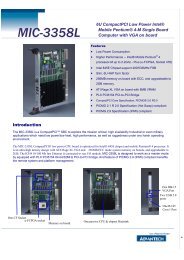industrial wireless book special edition - Networking ...
industrial wireless book special edition - Networking ...
industrial wireless book special edition - Networking ...
Create successful ePaper yourself
Turn your PDF publications into a flip-book with our unique Google optimized e-Paper software.
What is Spatial Multiplexing?<br />
SM provides a <strong>wireless</strong> system an opportunity to increase throughput without the use of additional<br />
spectral bandwidth. A simplified view of SM can be thought of as transmitting N unique data streams<br />
using highly directional antennas aimed at N different receive antennas. Each receiver detects a unique<br />
data stream resulting in an N fold increase in throughput. With sophisticated signal processing techniques<br />
it is possible to achieve a similar N-fold improvement using N (or more) omni-directional antennas.<br />
For example, in a standard WLAN 802.11g access point a second data stream can be transmitted from<br />
a second antenna. It is possible for a laptop with two receive chains to decipher the two (different) data<br />
streams, effectively doubling the throughput. A third antenna (at both the transmitter and receiver) can<br />
triple the data rate and so on.<br />
There is an upper bound, however. Analogous to solving an algebra problem of N unknowns from M<br />
independent equations (M N), in SM systems the maximum number (N) of data streams is restricted<br />
to the number (M) of independent (uncorrelated) signals received. Here, uncorrelated signals are radio<br />
signals that took different physical paths (multipath) from a transmit antenna to the receive antennas.<br />
In other words, throughput improvement is limited by the number unique signal paths. Furthermore,<br />
the multipath conditions are completely dependent on the environment where the WLAN is deployed.<br />
Winston Sun Atheros Communications<br />
becomes more important as areas become<br />
larger, such as in warehouses and in outdoor<br />
environments, as reflections and echoes<br />
become more likely to continue after the short<br />
guard interval would be over.<br />
The guard interval that was set in IEEE 802.11<br />
specifications prior to 802.11n was longer than<br />
needed in many environments. A shorter guard<br />
interval was added as an option in the 802.11n<br />
specification to allow for higher data rates<br />
where the long guard interval is not required.<br />
Frame Aggregation. Data over wired and<br />
<strong>wireless</strong> networks are sent as a stream of<br />
packets known as data frames. Frame aggregation<br />
takes these packets and combines them<br />
into fewer, larger packets allowing an increase<br />
in overall performance. This was added to the<br />
802.11n specification to allow for an additional<br />
increase in performance. Frame aggregation is<br />
a feature that only 802.11n clients can take<br />
advantage of since legacy clients will not be<br />
able to understand the new format of the larger<br />
packets.<br />
Reduced Inter Frame Spacing (RIFS). The<br />
standard spacing between IEEE 802.11 packets<br />
is known as the Short Inter Frame Space (SIFS).<br />
IEEE 802.11n adds a smaller spacing between<br />
the packets when a larger spacing isn’t<br />
required. This reduces the overhead and slightly<br />
increases throughput. This was added to the<br />
802.11n specification to increase performance<br />
where possible. RIFS is a feature that only<br />
802.11n clients can take advantage of since<br />
legacy clients will not be able to receive<br />
packets with the shorter spacing.<br />
The maximum possible data rates when using<br />
802.11n with and without channel bonding,<br />
using one through four theoretical spatial<br />
streams, with both long and short guard<br />
intervals are listed in Table 1.<br />
Of particular note is that today’s radio<br />
chipsets generally do not support more than<br />
two spatial streams, nor do they support a true<br />
‘green-field’ configuration. Also the data rate<br />
sponsored by Advantech<br />
<strong>industrial</strong> ethernet <strong>book</strong><br />
describes the PHY-level encoding rate over the<br />
air which has significant overhead. The actual<br />
wired bandwidth throughput is roughly 50% of<br />
the data rate.<br />
One simple conclusion is that we will see<br />
future generations of chipsets capable of even<br />
higher bandwidths than exist today.<br />
Long (800ns) Guard Interval<br />
Table 2. 802.11n Performance<br />
Short (400ns) Guard Interval<br />
Table 1. The effects of channel bonding and Guard<br />
Interval set against the maximum attainable data rate<br />
using IEEE 802.11n<br />
Backwards compatibility<br />
An 802.11n AP is backwards-compatible with<br />
legacy IEEE 802.11b/g (2.4GHz) or 802.11a<br />
(5GHz) clients. Please note, however, that there<br />
is a performance trade-off in this configuration,<br />
similar to that observed with an 802.11g<br />
AP supporting 802.11b clients.<br />
● Though legacy clients will benefit somewhat<br />
from the extended range that an 802.11n AP<br />
can offer, they are not capable of the higher<br />
data rates.<br />
● An 802.11g client takes longer to send a<br />
given amount of data when compared to an<br />
802.11n client, therefore the 802.11g client<br />
will consume more ‘air time.‘ This has the<br />
impact of limiting the airtime available to<br />
802.11n clients which, in a congested state,<br />
will reduce 802.11n performance.<br />
802.11n compatibility modes. An 802.11n<br />
access point can be configured to operate in three<br />
modes; Legacy, Mixed and Green-field Modes.<br />
Legacy mode. In this mode, the access point<br />
is configured to operate just like an 802.11a or<br />
802.11g device. No benefits of 802.11n such as<br />
MIMO or channel bonding are used. This mode<br />
could be used when an enterprise buys a new<br />
802.11n access point and, although some<br />
clients may have 802.11n capabilities, the<br />
company chooses consistency among user<br />
experience over maximum possible speed. In<br />
Legacy mode, 802.11n capabilities exist, but<br />
are not turned on.<br />
Mixed mode. This mode will be the most<br />
popular of the possible deployments. Here, the<br />
access point is configured to operate as an<br />
802.11n AP while also communicating with<br />
802.11 a/b/g stations. When configured for<br />
mixed mode, the 802.11n access point must<br />
provide ‘protection’ for the older 802.11<br />
devices, in much the same way that 802.11g<br />
access points would communicate with 802.11b<br />
clients. Thus the presence of an 802.11a/g<br />
client reduces the overall bandwidth capacity<br />
of the 802.11n access point, in part because of<br />
the lower data rates at which the a/g clients<br />
communicate.<br />
Green-field mode. This mode is described in<br />
the standard and assumes that only 802.11n<br />
stations operate on the network, with no<br />
protection mechanisms for 802.11 a/b/g<br />
necessary. Most current 802.11n chipsets do<br />
not support this mode, as the incremental<br />
performance benefit is small and it is expected<br />
that mixed mode will be prevalent for the near<br />
future.<br />
IEEE 802.11n in the future<br />
802.11n provides significant improvements in<br />
WLAN performance and reliability for 802.11n<br />
clients, as well as performance and reliability<br />
improvements to existing legacy clients. MIMO<br />
takes the challenge of multipath interference<br />
and uses it to increase performance and reliability<br />
of the overall network. The addition of<br />
channel bonding can realise significant benefits<br />
in performance as well. The combination of<br />
these innovative features allows immediate<br />
advantages to be seen when migrating to an<br />
802.11n <strong>wireless</strong> network, even with legacy<br />
clients. The benefits only increase as more<br />
clients become 802.11n-capable over time. The<br />
increase of performance, throughput, and reliability<br />
of 802.11n allows the WLAN to become<br />
a viable alternative/companion to the wired<br />
network for high bandwidth and robust applications.<br />
From the paper The Network Inpact of 802.11n by<br />
Adam Conway, VP Product Management,<br />
Aerohive Networks<br />
www.aerohive.com<br />
First published in the <strong>industrial</strong> ethernet <strong>book</strong> July 2010<br />
Industrial Wireless<br />
9

















